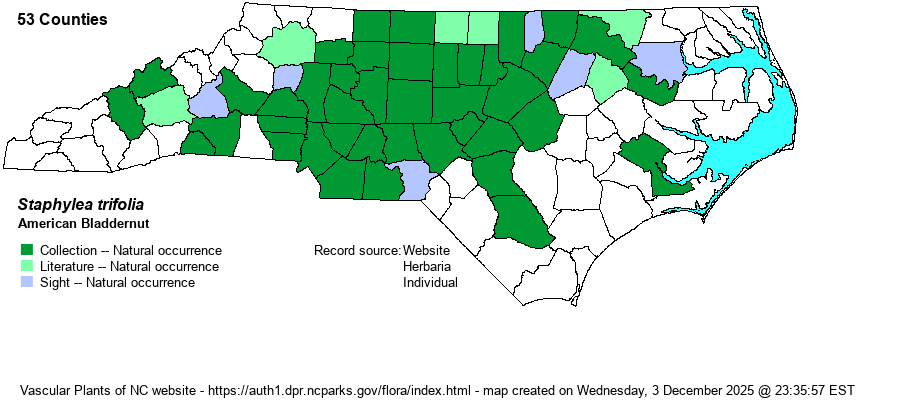| Author | L. | |
| Distribution | Essentially throughout the Piedmont; limited in the Coastal Plain to rich soils in brownwater river floodplains. Present only in a few low elevation areas in the Mountains and foothills. Note that the BONAP and UNC Atlas maps are incorrect or outdated in the Coastal Plain, as the species is present in all four counties – Halifax, Northampton, Martin, and Bertie – containing large amounts of the Roanoke River floodplain.
This is an Eastern species ranging north to NH, southern Canada, and MN, south to northwestern FL and LA. It main distribution lies north and west of NC. | |
| Abundance | Infrequent to fairly common in the eastern and central Piedmont, but scarce in the western Piedmont. Very rare in the Mountains. Locally fairly common along the Roanoke and Cape Fear rivers in the Coastal Plain, but very rare elsewhere in brownwater rivers (such as in Craven County). It is absent over most of the rest of the Coastal Plain. | |
| Habitat | This species requires very rich soil, mainly in brownwater bottomland forests, on forested natural levees, and also on lower slopes, but on slopes only where over circumneutral soil (i.e., Basic Mesic Forest). It is often found with woody species such as Painted Buckeye (Aesculus sylvatica) and Common Pawpaw (Asimina triloba), though it is usually less widespread than they are. |
| Phenology | Flowers in April and May, and fruits from August to October. | |
| Identification | This is a large shrub to rarely a small deciduous tree, often with several trunks, reaching a height of about 10-12 feet tall. It is usually easily identified, as it has opposite leaves that are trifoliate, with each leaflet being elliptical and about 1.5-2 inches long. The leaflets are distinctly finely-toothed on all margins. Also, the flowers are helpful for identification, as they are small, creamy-white to dull white, somewhat bell-shaped, about 3/8-inch long and in drooping clusters in spring. Most conspicuous in summer and fall are the very large bag-like capsules –- pale green for a while but turning brown in fall -– that are often 2 inches long. These fruit give rise to the common name of “bladdernut”. The plants often grow in fairly tight stands, as usually a handful or more are found when you first encounter the species. | |
| Taxonomic Comments | This is the only member of the genus in most of the USA; another is found in CA, and a few dozen others are found outside of North America.
| |
| Other Common Name(s) | Bladdernut | |
| State Rank | S4 [S4S5] | |
| Global Rank | G5 | |
| State Status | | |
| US Status | | |
| USACE-agcp | FAC link |
| USACE-emp | FAC link |

